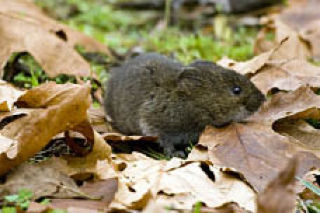A Townsend’s vole enjoying a salad.
Long before Coast Salish people discovered that weeding and hoeing increased the size and abundance of bulbs in camas fields, an inconspicuous native rodent already was tilling the islands’ flower meadows!
Townsend’s vole (Microtus townsendii) is the San Juan Islands’ most widespread native rodent. American naturalist John Kirk Townsend, for whom our native chipmunk is also named, collected the first specimens near Fort Vancouver in 1836. It is only found in lowlands of the Salish Sea, coastal Oregon, and Humboldt Bay in northern California. Although it prefers fields and meadows, our native vole is a strong swimmer that often lives in wetlands and can burrow into stream banks underwater. Up to nine inches long, it is sometimes mistaken for a muskrat!
University of Washington zoologist William Dalquest classified San Juan County voles as a sub-species (M. townsendi pugeti) on the basis of eight individuals collected on Shaw and San Juan Island in 1940. We have begun collecting road-kill and cat-kill voles for genetic analysis to find out how isolated they really are from their mainland cousins. Meanwhile state and federal agencies regard the “Shaw Island vole” as a candidate for protection due to its limited geographic range—and rapid destruction of its habitat in the islands.
The fate of island voles might be of little interest were it not for growing evidence of their key role in maintaining the islands’ native flower meadows, in particular species such as blue camas, chocolate lily, harvest brodiaea, and Indian carrot (yampah) that store energy in small bulbs, corms, or tubers.
Island voles form extended families of up to several hundred individuals living in subterranean burrows connected by networks of runways on the soil surface. Most active at night, voles feast on fresh green stems and leaves in summer, but depend on digging up and caching bulbs, corms and tubers the rest of the year. Digging is particularly obvious in January to April, as voles clean out their burrows and search frantically for fresh bulbs and tubers to replenish their winter stores and feed their first litter of the year. Two, even three more litters may follow in summer depending on food supplies.
Vole families grow for several years, achieving densities as great as 600 per acre, then crash and start over. We have observed this at Iceberg Point, where one vole family in a patch of Indian carrot peaked in 2006, crashed in 2007, and is just recovering now.
More than a decade ago, biologist Neal Hedges and local botanist Paul Edgerton suggested that voles, not fire, have been the principal natural disturbance in the islands’ meadows. Our more recent observations indicate that vole excavations suppress grasses (most of which are non-native) and promote the native flowering plants that voles like to eat, such as brodiaeas and Indian carrot, which re-sprout immediately in vole back-dirt. Many native flowering plants actually produce a halo of tiny bulblets or cormlets around the main bulb or tuner. When a vole pulls out the main one, the small ones are released, and take advantage of the exposed soil to grow rapidly, outstripping the grasses!
In addition to tilling our flower meadows, voles are the preferred native prey of the islands’ hawks and owls. They are also prey for herons, minks, weasels, the largest of our native garter snakes, and on San Juan Island, non-native foxes.
Voles are sometimes discovered as pests in gardens and orchards. Wrap trees in 18 inches of hardware cloth to prevent voles from gnawing the bark, or use traps and resettle the voles in an uncultivated field or meadow. Adding rocks to your garden is also an effective way of discouraging voles. Never use poison, since poisoned voles are very likely to be eaten by our native hawks, owls, or eagles.
Russel Barsh and Madrona Murphy study voles and flower meadows as part of their work for Lopez-based nonprofit conservation laboratory Kwiáht, www.kwiaht.org. And they are always happy to receive frozen road-kill and cat-kill voles!



